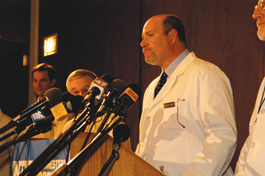home | metro silicon valley index | movies | current reviews | film review

Waiting game: After an assassination attempt, all eyes turn to the hospital in 'Death of a President.'
Faux Doc Chiller
Faux documentary 'Death of a President' avoids scandal but never rises above its good intentions
By Jeffrey M. Anderson
IN Death of a President, many moviegoers probably imagined an angry fantasy in which a global bully gets his comeuppance. But in fact, the much-ballyhooed faux documentary is so carefully centrist that it could almost be used as a training film to help seal the current rift between red and blue states. Directed by BBC veteran Gabriel Range, the film takes place approximately a year from now. As the war in Iraq still rages and North Korea continues rattling its sword, President George W. Bush (seen here in real news footage) makes a stop in Chicago for a rousing speech. The film sets up the speech with talking-head interviews from his (fictional) staff, each talking in the past tense (sometimes tearfully) about his strengths and his passions. Range cuts and arranges the speech itself in such a way that Bush comes across as warm and galvanizing.
To get to the Chicago Sheraton, the president's motorcade must drive past an army of angry protesters. Seated next to him in the presidential limo, his speechwriter, Eleanor Drake (Becky Ann Baker), informs us that the president "respected their opinions but wished that they could protest peacefully." Tellingly, Drake also refers to the leader of North Korea as "Kim Il-Jong" (rather than Kim Jong-Il). The shooting scene itself—achieved through use of computers and a body double—comes and goes fairly quickly, followed by a grueling hospital stay. It's enough time for loved ones and devoted employees to exchange thoughts and prayers.
No matter where one's political ideals lie, it's hard not to empathize. Conversely, the mob of liberal protesters is treated like a pack of unthinking animals, self-righteous and destructive. One truly horrifying shot shows a section of the mob cheering at the news of the president's death. From there, the movie takes a subtle turn, showing the Republicans' folly as they chase suspects. The newly appointed President Cheney uses the assassination to ramp up the Patriot Act to a new extreme. In keeping with the party line, they desperately try to pin the crime on a Muslim and/or Al Qaeda member, but even their best suspect (Malik Bader) can't quite fill the bill. Miraculously, Death of a President actually finds an ending that's both surprising and ultimately satisfying for all viewers.
Range's documentary technique, blending real footage with his new, fictitious footage, is above reproach, and even his talking-head sequences have a certain dramatic potency. Like United 93, the film uses mostly unrecognizable actors to occupy the key roles, though I did spot Hal Hartley regular James Urbaniak (he also played Robert Crumb in American Splendor). But despite its technical excellence and its careful balance, the film eventually dims its own fire; it can't equal the queasy power of Kevin Willmott's CSA: The Confederate States of America, another recent faux doc. Slightly lower-tech, but far more incendiary, CSA imagines the United States if the South had won the Civil War (it comes complete with commercials for slave-related products). In moving farther away from reality, that film gets closer to home.
![]() Death of a President (R; 93 min.), directed by Gabriel Range, written by Simon Finch and Gabriel Range and starring James Urbaniak and Becky Ann Baker, opens Oct. 27 at the Los Gatos Cinema and the Guild in Menlo Park.
Death of a President (R; 93 min.), directed by Gabriel Range, written by Simon Finch and Gabriel Range and starring James Urbaniak and Becky Ann Baker, opens Oct. 27 at the Los Gatos Cinema and the Guild in Menlo Park.
Send a letter to the editor about this story.
|
|
|
|
|
|